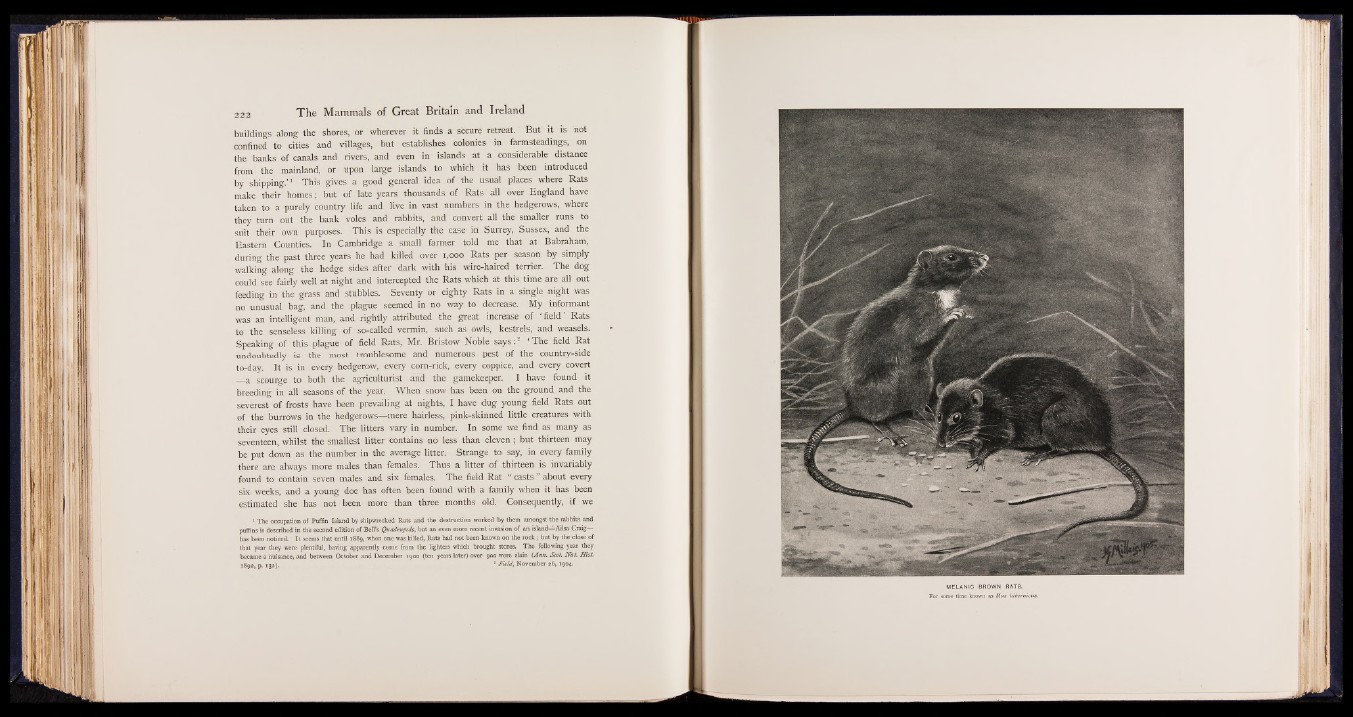
buildings along the shores, or wherever it finds a secure retreat. But it is not
confined to cities and villagés, but establishes colonies in farmsteadings, on
the banks of canals and rivers, and even in islands at a considerable distance
from the mainland, or upon large islands to which it has been introduced
by shipping.’ 1 This gives a good general idea of the usual places where Rats
make their homes; i but of late years thousand#’ of Rats all over England have
taken to a purely country life and live in vast numbers in the hedgerows, where
they turn out the bank voles and rabbits, and convert all the smaller runs to
suit their own purposes. This is especially the case in Surrfey; Sussex, and the
Eastern Counties. In Cambridge-.a: small farmer told me that at Babraham,
during the past'three years he had killed overiMooo Rats per season by simply
walking along the hedge sides after dark with His wire-haired terrier. The dog
could sec fairly well at night and intercepted the Rats which at this time are all óüt
feeding in thé grass and stubbles. Seventy or eighty Rats in a single night was
no unusual bag, and the plague seemed in no way to decrease. My informant
was an intelligent man, and rightly attributed the great increase of 'field' Rats
to the senseless killing of so-called vermin, ■ such as Owls, kestrels, .and weasels.
Speaking of this plague of field Rats, Mr. Bristow Noble says:* 'The'field Rat
undoubtedly is the most troublesome, and numerous pest -of the ’ country-side,
to-day. It is in every hedgerow, every corn-rick, every coppice, and-every , covert
g jj§ | scourge to both the agriculturist and the gamekeeper. I have found it
breeding in all seasons of the year. When snow has been on the ground, and the
severest of frosts have been .prevailing at nights, I havé dug young field. Rats Out
of the'burrows in the hedgerows'—mere hairless, pink-skinned little creatures with
their , eyes still closed. The litters vary in number. In some we find as many as
seventeen, whilst the smallest litter contains no'less’ than eleven; but thirteen may
be put down as the number in the average litter. Strange to say, in every'family
there are ^always' more males than females, . Thus a litter of thirteen, is invariably
found to contain seven males and six fem a lfi The field Rat “ casts” about every
six weeks, and a young doe has often been found with a family when it has been
estimated she has not been more than three months old.- Consequently, if we
1 The occupation o f Puffin Island by shipwrecked Rats and the destruction worked by them amongst the rabbits and
puffins is described in the second edition of Bell’s Quadrupeds, but an even more recent invasion of an island—Ailsa Craig—
has been noticed. It seems that until 1889, when one was killed, Rats had not been known on the rock; but by the close of
that year they were plentiful, having apparently come from the lighters which brought stores. The following year they
became a nuisance, and between October and December 1900 (ten years later) over 900 were slain (Ann. Scot. Nat. Hist.
1892, p. 132); . t . . . . . . * Held, November 26,1904.